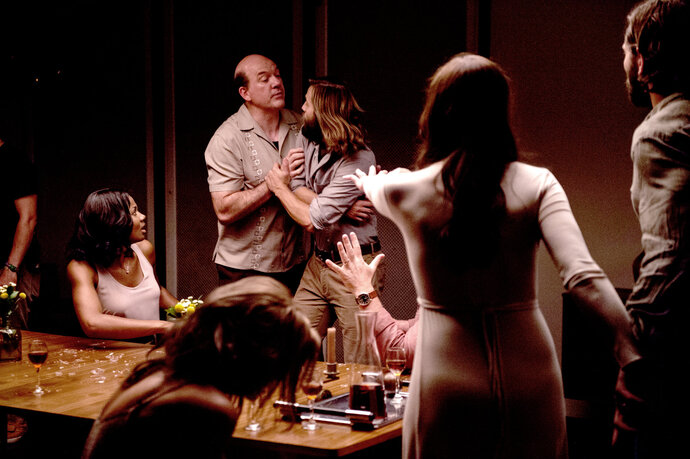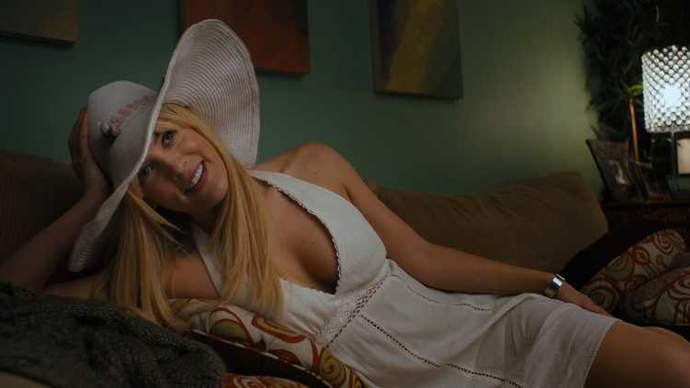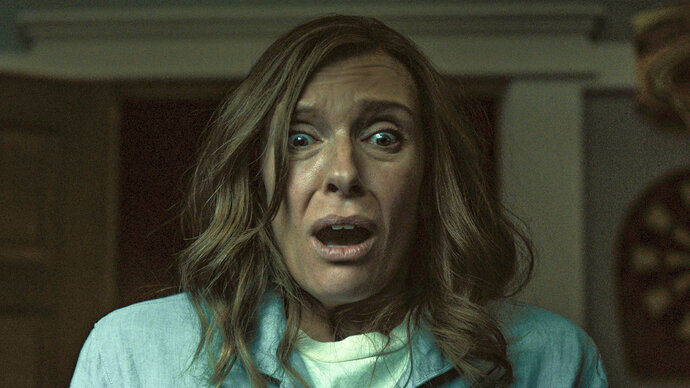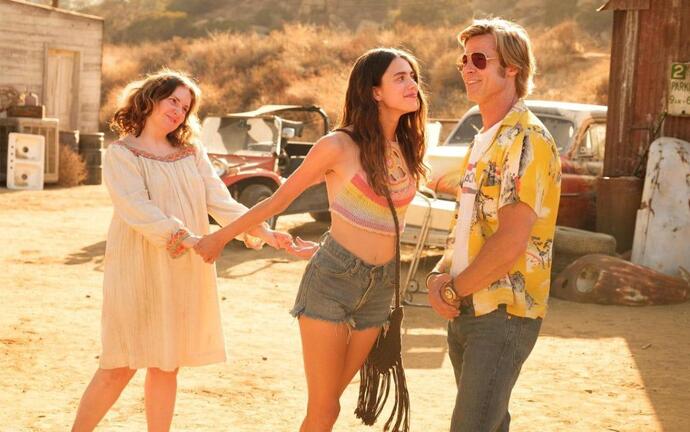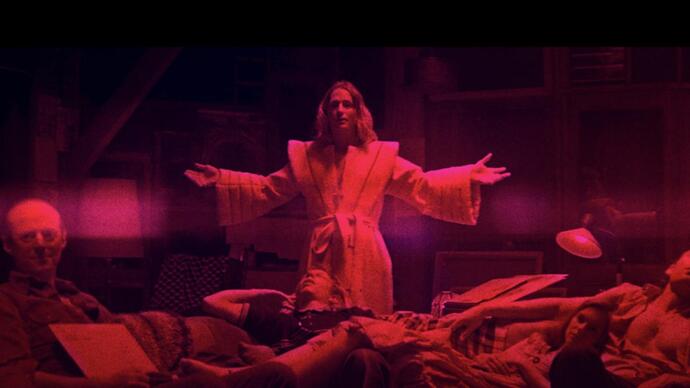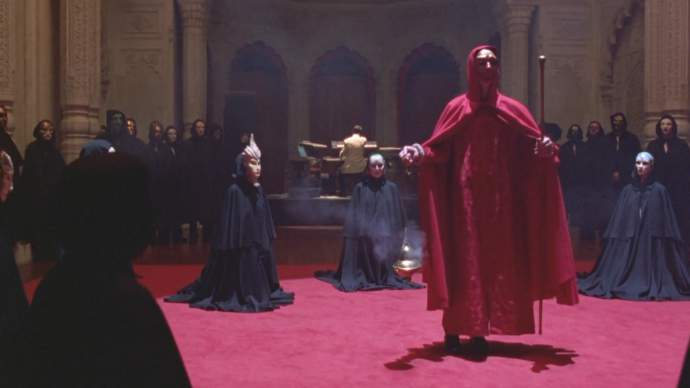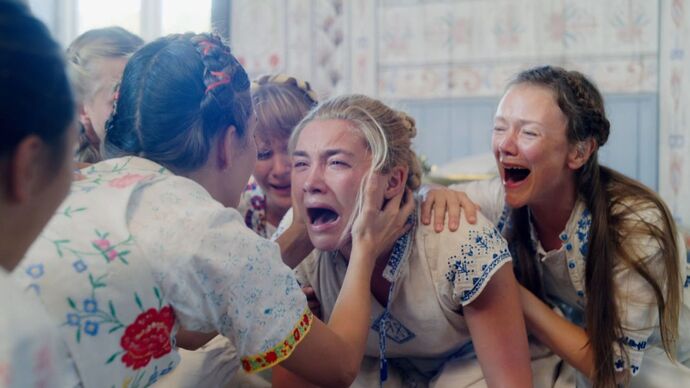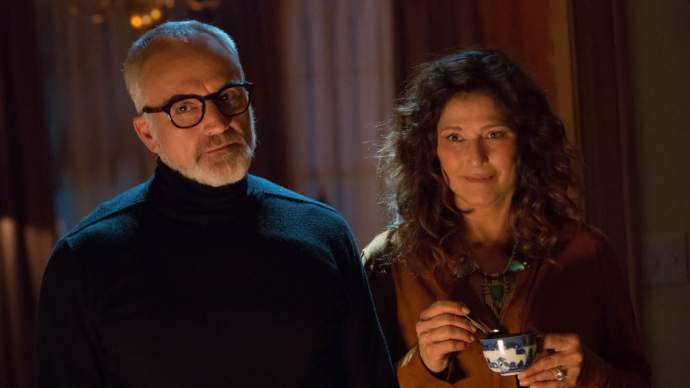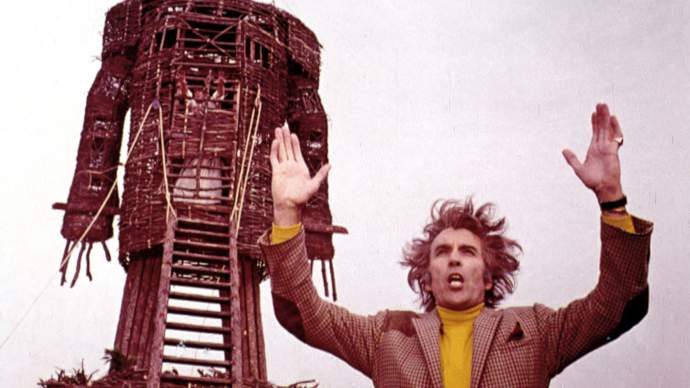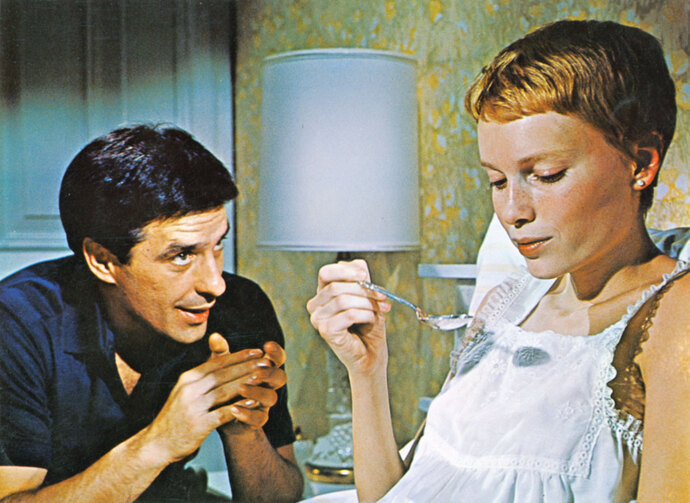Cults tends to lure in the gullible and innocent (or mostly innocent) with a false picture of normalcy, which eventually creates an uneasy atmosphere that makes it hard to discern who to trust. The horror and thriller movie genres have a lot of material to work with when it comes to cults. Here are the best movies about cults that make good use of the creepy premises.
10. The Invitation (2015)
The Invitation is an atmospheric chiller directed by Karyn Kusama (also known for Jennifer’s Body). The scope of this indie flick is small, but it’s effective due to the intimate setting and events that unfold over a single night, which gives it a claustrophobic feel. Logan Marshall-Green and Michiel Huisman star in this uncomfortable horror about a dinner party reunion that goes disastrously wrong. The dinner is hosted in Will’s (played by Marshall-Green) old house, which his ex-wife now shares with her new boyfriend. The door is locked (apparently for “safety reasons”) and the atmosphere turns from awkward, to sour, to deadly. You could cut the tension of The Invitation with a knife. The violent ending probably could have been avoided had the guests listened to Will’s instincts. Alas, they decide to listen to their host’s preaching instead, who attempts to recruit them to his bizarre cult. “The Invitation” is disguised as a healing spiritual group, designed to help the grief-stricken. But unusual party games, indecent proposals, and poisoned drinks tell us something dark is afoot.
9. Under the Silver Lake (2018)
The codes and symbols in Under the Silver Lake are still being deciphered by audiences ever since it released in 2018, with no definitive meaning having been settled on yet. A swarve A24 film, Under the Silver Lake takes place in sunny Los Angeles—but not all is golden. It stars Andrew Garfield as the aimless thirty-something Sam who’s dawdling around LA, getting stoned and never paying rent. When his new neighbor suddenly goes missing, Sam begins to notice hidden signs and messages all around him, painted on the walls and published in underground comics. He feels a connection to the recent pet murders, religious pop bands, and prostitutes, but fails to draw any meaningful conclusions. The pop-culture references and obscure cyphers are never fully explained, leaving viewers to ponder the bigger conspiracy behind the film. (A cryptographer encoded the movie with subtle messages, using techniques like Morse code and the Copiale cipher.) By the end, whatever cult Sam has tapped into sends him a message: “Stay quiet.” Quiet about what? We aren’t completely sure. But it sure is interesting to wonder. Plus, the cinematography is pretty neat.
8. Hereditary (2018)
Hereditary may seem like your usual horror flick at first, as it isn’t until the end that the cult aspects come into focus. Director Ari Aster—who loves to terrify his audiences—collaborates with Toni Collette, Alex Wolff, and Gabriel Byrne for his debut. And what a debut it is! Hereditary tells the supernatural story of a family plagued by an uncomfortable presence after the death of their grandmother. It seems as if their ancestors control the family’s future, with death and demons haunting all the days ahead. Hereditary is a breakdown of family dynamics and the characters’ sense of sanity—a glimpse into the bleak world of Aster’s growing horror filmography. The possession and religious imagery of the final scene symbolize Hereditary’s cult undertones, which run like invisible currents through the film. Prepare for some real plot shockers and impassioned performances, most notably from Collette and Wolff.
7. Once Upon a Time in Hollywood (2019)
While the main plot of Once Upon a Time in Hollywood isn’t about a cult, the movie does feature one of the most infamous cults of all time. Margot Robbie appears alongside Leonardo DiCaprio and Brad Pitt as the side character Sharon Tate, who was really murdered in real-life by the Manson family back in the 1960s. Although the bulk of Quentin Tarantino’s movie follows washed-out actor Rick Dalton (played by DiCaprio) and his stunt double Cliff (played by Pitt), the Manson family is integrated into the plot at large. When Cliff finds himself at a deserted ranch filled with hippies, the commune don’t exactly warm to him. This comes to bite both him and Rick on the butt, who are later attacked by the hippies under Charles Manson’s leadership. The Manson gang had roughly 100 members, energized by a craze for LSD and crime. Once Upon a Time in Hollywood uses this historical context as a basis for fiction: the characters who come to kill Tate end up in her neighbor Rick’s house. A very bloody and true-to-Tarantino-style ending follows, with half the characters tripping and the other half brandishing axes. It’s a hectic and brutal finale, but what else would you expect when Tarantino gets his hands on cult material?
6. Mandy (2018)
Crazy-eyed and chugging straight vodka, Mandy shows us Nicolas Cage like never before. This avant-garde horror movie, directed by Panos Cosmatos, is a furious revenge flick against the Black Skulls. This twisted cult is made up of sadomasochistic former-drug couriers, who turned loco after consuming LSD. The whole movie is like one bad trip, both narratively and visually. Saturated in smoky red, Mandy is somehow stunning despite its violently graphic story. Starting the movie in the subdued Shadow Mountains, Red Miller (played by Cage) swaps his quiet life for a bloodthirsty manhunt when his wife Mandy is kidnapped by the Children of the New Dawn—a demonic hippie commune—with the help of the Black Skulls. Now, Red is out for blood. Cannibals and cults litter every which way of Mandy, fueled by psychotic drugs and strange folk music. Mandy reverberates with a sort of agony—from Mandy’s traumatic childhood to Rick’s grief and alcoholism. It all plays out like a feverish nightmare… one we can’t take our eyes off.
5. Eyes Wide Shut (1999)
Stanley Kubrick made several perverse masterpieces in his time, most notably 1971’s A Clockwork Orange to 1980’s The Shining. Later on, he would give us another brilliant film in 1999’s mystery-drama Eyes Wide Shut, which screened just six days before Kubrick died. In his final legacy, Eyes Wide Shut features controversial eroticism as it stars then-celebrity couple Tom Cruise and Nicole Kidman in 1990s New York as they go from unfulfilled marriage to underground sex cult. Based on Arthur Schnitzler’s 1926 novella Traumnovelle (or “Dream Story”), Eyes Wide Shut follows Dr. Bill Harford who’s called to the house of a patient, which ends up with him at a jazz bar where masks and costumes are required. By joining the secret club, Bill puts his life and his family’s lives in danger. The near-three-hour runtime bristles with tension and intrigue. It’s disturbing, uncanny, and somewhat surrealist. It may be set around Christmas, but it won’t be your family’s festive favorite.
4. Midsommar (2019)
Ready to get tripped out? Director Ari Aster’s hallucinogenic horror Midsommar is wild from start to finish. Midsommar was shot on the sweeping hills of Budapest, luring its characters into a beautiful, natural world of witchy rituals. The A24 hit is a visual stunner that draws viewers in with optical illusions that replicate the effects of magic mushrooms. Florence Pugh stars as the vulnerable Dani, who’s traumatized after her sister’s suicide. Despite being a psychology student, Dani’s mind is still susceptible to the manipulation she comes to face. In an attempt to rekindle her relationship with Christian (played by Jack Reynor), Dani attends the midsummer festival of a Swedish commune—a festival that only happens every 90 years. But beyond the flower crowns and hippy vibes, something much darker awaits. The traditional folk setting soon becomes sinister and absurd. Pagan imagery turns to blood and guts, and Dani is given more than she bargained for.
3. Get Out (2017)
Director Jordan Peele never expected Get Out to become the huge success it was. When he wrote and directed the film, he was simply using the horror genre to explore issues of modern racism. The movie’s central cult has its roots in white supremacy. Perhaps that’s what makes it so creepy—because it’s so real. Racism isn’t some far-off supernatural force, but a deeply buried vein of suburban America (where Get Out is set). Daniel Kaluuya gives a strong performance as Chris, a black American man who visits his white girlfriend’s family home. Passive-aggressive family members and their black housekeepers put Chris on edge—and later he falls off the cliff altogether. The villains of Get Out may not boast skinheads and Swastika tattoos, but they’re just as scary in their own way. Get Out won’t just leave you horrified, but full of reflection, questions, and contemplation.
2. The Wicker Man (1973)
The cult classic The Wicker Man is full of Pagan qualities as it takes place on the Scottish island of Summerisle. Mysterious islands with no escape are never a good call. Sergeant Neil Howie (played by Edward Woodward) visits Summerisle to investigate a missing child report, which leads him down a rabbit hole of strange Celtic rituals and annual harvest festivities. Agronomist Lord of Summerisle (played by Christopher Lee) oversees all the peculiar inhabitants, who chant, dance, and claim the missing child never existed. The Lord’s daughter Willow (played by Britt Ekland) is of particular temptation to Neil as she seduces him with her sexual frivolousness. Robin Hardy directs this 1970s folk horror—one that’s often cited in pop culture. Both serious and terror-inducing, The Wicker Man is highly regarded by critics. A must-watch for any horror-lover!
1. Rosemary’s Baby (1968)
Based on Ira Levin’s 1967 psychological horror novel, Rosemary’s Baby is a cultural landmark of cinema. Directed by the infamous Roman Polanski, this film triggered a string of cultish films throughout the 1970s that were dedicated to Satanic worship. A young Mia Farrow plays Rosemary, who moves into a New York apartment with suspicious neighbors and an eerie atmosphere. Overjoyed to be with child, her pregnancy quickly takes a sickly turn and she believes the baby isn’t human. Nobody believes her, but she ain’t exactly wrong. Selected for preservation by the National Film Registry, Rosemary’s Baby was super daring for its time and remains just as shocking today—especially for its weird psychedelic rape scene. The booming counter-culture of the 1960s instantly fell in love with this accursed tale of the occult. Its themes of feminism, paranoia, and religion make it a timely story for then and now. Read next: The best horror movies without blood or gore

